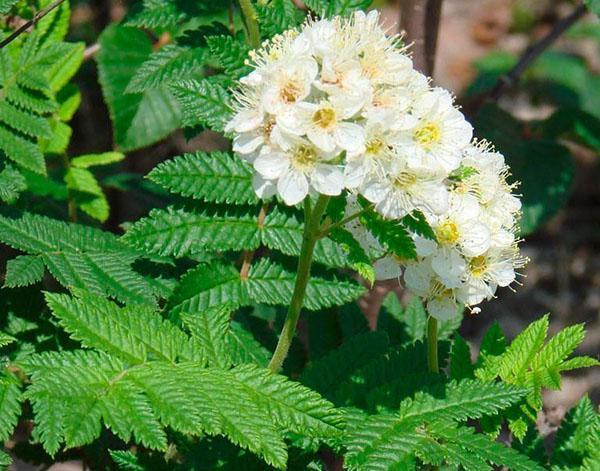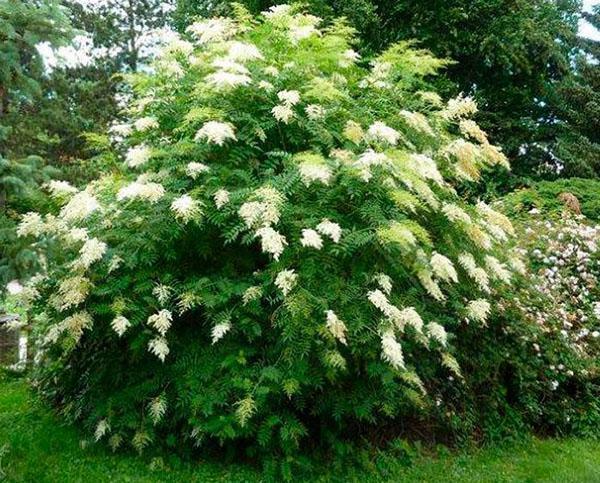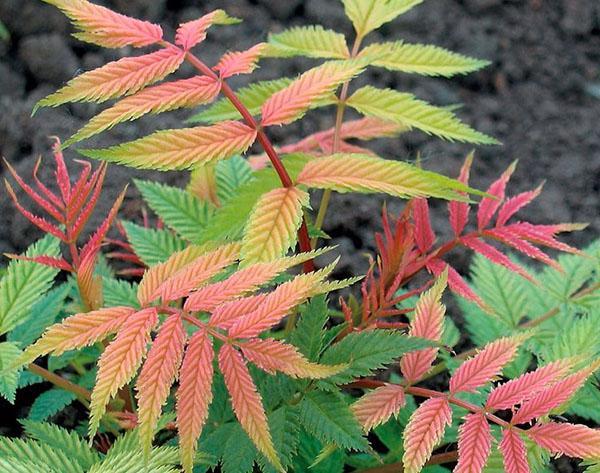Spectacular types of fieldfare for decorating a summer cottage
 For thousands of years, people have sought to create around themselves a kind of Garden of Eden. To do this, they grew various plants, including all sorts of fieldfare, which blooms almost all summer. Today there are more than 10 varieties of this shrub. Therefore, it is actively used to decorate the landscapes of the suburban area.
For thousands of years, people have sought to create around themselves a kind of Garden of Eden. To do this, they grew various plants, including all sorts of fieldfare, which blooms almost all summer. Today there are more than 10 varieties of this shrub. Therefore, it is actively used to decorate the landscapes of the suburban area.
Biological information

 In early spring, the foliage is pink. In summer, it becomes a rich green tone. And in the fall they acquire a red or yellow color.
In early spring, the foliage is pink. In summer, it becomes a rich green tone. And in the fall they acquire a red or yellow color.
All types of fieldfare boast fragrant buds that look spectacular against the background of lush greenery for 3 months (June-August). They are collected in lush panicles and painted in the following colors:
- white;
- yellow;
- cream.
To preserve the decorativeness of the plant, the faded panicles are cut off. Since the fruits of the bush are unsightly. Various types of fieldfare are widely used as hedges. Mature plants grow to over 2 m in height and have a wide crown, consisting of many shoots.
The first flowering occurs 3 years after the plant is planted on the site. Therefore, you should not worry in vain if the field ash pleases only with lush greenery.
Popular types of fieldfare: description and photo of the plant
 The homeland of this pretty shrub is the southern part of Siberia, China, Japan and Mongolia. The decorativeness of the plant prompted breeders to create various varieties that would decorate the plots of our compatriots. There are more than 10 varieties of them. Let's get acquainted with the most popular copies.
The homeland of this pretty shrub is the southern part of Siberia, China, Japan and Mongolia. The decorativeness of the plant prompted breeders to create various varieties that would decorate the plots of our compatriots. There are more than 10 varieties of them. Let's get acquainted with the most popular copies.
Mountain ashberry (Sorbaria sorbifolia)
 In nature, the shrub is found next to lakes, rivers or streams. It grows up to 2 m in height. It has erect gray shoots, which acquire a brownish tint with age. In spring, the spreading crown of field ash (Sorbaria sorbifolia) shimmers with orange-pink foliage of large sizes. With the onset of cold weather, it becomes crimson, for which it is very appreciated by gardeners.
In nature, the shrub is found next to lakes, rivers or streams. It grows up to 2 m in height. It has erect gray shoots, which acquire a brownish tint with age. In spring, the spreading crown of field ash (Sorbaria sorbifolia) shimmers with orange-pink foliage of large sizes. With the onset of cold weather, it becomes crimson, for which it is very appreciated by gardeners.
The shrub blooms with miniature cream-colored buds, collected in pyramidal panicles. They are wonderfully pollinated by insects, after which fruits in the form of leaflets appear in their place. The variety tolerates severe frosts, quickly takes root after transplanting and is not afraid of haircuts. Widely used as green hedge in summer cottages or as a single garden decoration. Also, the plant is planted to strengthen the slopes and coastal areas of small artificial lakes or pools.
Field ashberry Sam (Sorbaria sorbifolia Sem)
 This type of shrub differs from its relative in a compact rounded shape. It grows only up to 80 cm. Its leaf plates are colored light green with a bronze or reddish tint. Young shoots of fieldfare are covered with small villi that sparkle silver in the sunlight.
This type of shrub differs from its relative in a compact rounded shape. It grows only up to 80 cm. Its leaf plates are colored light green with a bronze or reddish tint. Young shoots of fieldfare are covered with small villi that sparkle silver in the sunlight.
During the flowering period, the shrub wears a “wedding veil” of many white buds. They are harmoniously collected in elongated inflorescences.Each flower has stamens 2 times longer than the petals. This gives them a special elegance. The variety loves open areas of the garden and moderate watering. Prefers fertile, drained soil. Calmly endures winter cold. Needs a sanitary haircut in the spring. The main pests: spider mite and aphids.
Fieldfare mountain ash Stelifila (Sorbaria sorbifolia Stellifila)
 The variety is distinguished by decorative leaf plates, the back of which is covered with serrated brown hairs. During the flowering period, and it lasts up to 3 weeks, the shrub “shines” with many snow-white bouquets. With proper care, it grows up to 2.6 m in height. It tolerates low temperatures comfortably. Loves fertile soil types. The field ashberry Stelifila is grown both in open areas and in the shade. He painlessly tolerates a haircut and easily propagates by layering or lignified cuttings. It has a special resistance to pests and practically does not get sick.
The variety is distinguished by decorative leaf plates, the back of which is covered with serrated brown hairs. During the flowering period, and it lasts up to 3 weeks, the shrub “shines” with many snow-white bouquets. With proper care, it grows up to 2.6 m in height. It tolerates low temperatures comfortably. Loves fertile soil types. The field ashberry Stelifila is grown both in open areas and in the shade. He painlessly tolerates a haircut and easily propagates by layering or lignified cuttings. It has a special resistance to pests and practically does not get sick.
Fieldfare Pallas (Sorbaria Pallasii)
 In nature, the shrub is found on the slopes of the Alps, the Far East and Siberia. It grows up to 1.2 m. It has a rounded and lush crown. Young stems of the plant are colored brownish. They are naked or with small yellow villi. Old shoots are covered with exfoliated bark, which does not prevent the fieldfare from remaining attractive in the summer cottage.
In nature, the shrub is found on the slopes of the Alps, the Far East and Siberia. It grows up to 1.2 m. It has a rounded and lush crown. Young stems of the plant are colored brownish. They are naked or with small yellow villi. Old shoots are covered with exfoliated bark, which does not prevent the fieldfare from remaining attractive in the summer cottage.
The leaf plates of the plant grow up to 15 cm. They are located on a long petiole, up to 15 pairs each, and are colored dark green. And on the back side, the plates are slightly pubescent. The inflorescences consist of many snow-white or creamy buds, the diameter of which is only 1.5 cm. During flowering, they stand out clearly against the background of green foliage.
The shrub actively reproduces by root processes. To maintain a beautiful garden design, you need to remove them regularly. Otherwise, the landing site will turn into solid thickets.
Lindley's field ash (Sorbaria Lindleyana)
 The plant is found in Western Europe, North America, as well as on the slopes of the Himalayan mountains. It is a deciduous shrub like other species. It is best grown in the southern regions, where winters are not too harsh. The maximum temperature it tolerates is approximately –20 ° C with additional cover. Fieldfare stretches up to 3 m in height. The plant's light green foliage reaches approximately 25 cm in length, giving it a majestic appearance. With the arrival of the autumn cold, it acquires an exquisite carmine color.
The plant is found in Western Europe, North America, as well as on the slopes of the Himalayan mountains. It is a deciduous shrub like other species. It is best grown in the southern regions, where winters are not too harsh. The maximum temperature it tolerates is approximately –20 ° C with additional cover. Fieldfare stretches up to 3 m in height. The plant's light green foliage reaches approximately 25 cm in length, giving it a majestic appearance. With the arrival of the autumn cold, it acquires an exquisite carmine color.
The first buds on Lindley's fieldfare appear 4 or 5 years after planting in the garden. However, this does not prevent it from blooming for 2 months. The main thing is to plant bush in an open area. It is the only species of fieldfare that does not tolerate shaded areas. The shrub easily tolerates cutting, replanting and is not picky about the type of soil. It is used to decorate industrial areas, city parks and summer cottages.
The variety is actively developing with regular weeding from weeds and periodic loosening of the soil.
Felt fieldfare (Sorbaria tomentosa)
 For the first time, the shrub was found on the mountain slopes of East Asia. Grows up to 6 m in height. Has a wide crown, consisting of many shoots. It painfully tolerates low temperatures, so it needs additional shelter for the winter. The peculiarity of the species is that it does not bloom. Despite this, its main decoration is elongated leaf plates, which originally change their color throughout the growing season.
For the first time, the shrub was found on the mountain slopes of East Asia. Grows up to 6 m in height. Has a wide crown, consisting of many shoots. It painfully tolerates low temperatures, so it needs additional shelter for the winter. The peculiarity of the species is that it does not bloom. Despite this, its main decoration is elongated leaf plates, which originally change their color throughout the growing season.
Mountain ashberry (Sorbaria arborea)
 The main feature of the plant is slow growth. Despite this, for 10 years it reaches 6 m in height and is considered the tallest among its "relatives". The tree-like fieldfare is a lush shrub with foliage raised above the ground. From July to August, the plant is decorated with snow-white flowers collected in paniculate brushes. It tolerates severe winters and frost down to –25 ° C.It is successfully used for decorating summer cottages.
The main feature of the plant is slow growth. Despite this, for 10 years it reaches 6 m in height and is considered the tallest among its "relatives". The tree-like fieldfare is a lush shrub with foliage raised above the ground. From July to August, the plant is decorated with snow-white flowers collected in paniculate brushes. It tolerates severe winters and frost down to –25 ° C.It is successfully used for decorating summer cottages.
Decent place in landscape design
 To decorate the garden area of a country house, fieldfare is grown as a lonely shrub or in the company of other ornamental plants. Thanks to this, the territory acquires an exquisite look. The fieldberry bush in the middle of the lawn looks impressive and presentable against the background of a green grass carpet. During flowering, its lush bouquets attract not only insects, but also the views of nature lovers.
To decorate the garden area of a country house, fieldfare is grown as a lonely shrub or in the company of other ornamental plants. Thanks to this, the territory acquires an exquisite look. The fieldberry bush in the middle of the lawn looks impressive and presentable against the background of a green grass carpet. During flowering, its lush bouquets attract not only insects, but also the views of nature lovers.
With the help of group plantings, hedges are formed. Low-growing species are used for zoning areas.  The shrub goes well with tall conifers... The field ash with geyher, hosts and badans looks no less attractive. Why not breed such wonderful beauty on your site?
The shrub goes well with tall conifers... The field ash with geyher, hosts and badans looks no less attractive. Why not breed such wonderful beauty on your site?
 Various types of fieldfare allow you to create amazing landscapes on the territory of the backyard area. They do not require any special care and perfectly tolerate the winter cold. During flowering, they cause unprecedented delight of their owners. In addition, they are widely used in folk medicine to treat various ailments. May lush greenery always adorn our wonderful planet.
Various types of fieldfare allow you to create amazing landscapes on the territory of the backyard area. They do not require any special care and perfectly tolerate the winter cold. During flowering, they cause unprecedented delight of their owners. In addition, they are widely used in folk medicine to treat various ailments. May lush greenery always adorn our wonderful planet.